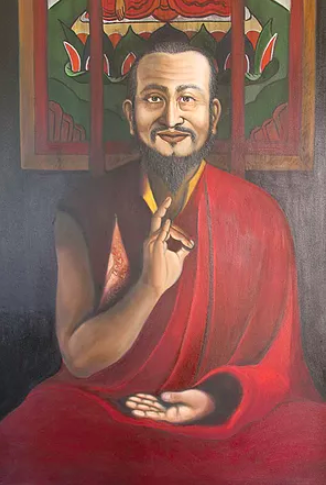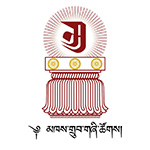Khedrup Jigme Kundrol, The First

Khedrup Jigme Kundrol, recognized as an emanation of Nyang Tingzin Zangpo and Gyelwa Chogyang, was born in 1730 in Wang DarLungkha, Thimphu, Bhutan, as Jangchub Gyaltshen (Byang Chub rGyal mTshan).
From an early age, he displayed a strong inclination toward spiritual practice. He began his formal Buddhist education at Trongsa Choekhor Rabten Tse Dzong, where he was admitted as a Toze (novice). During his studies, he was eventually appointed as the Supervisor of Meals in the Dzong. However, this position brought him deep discomfort due to the non-vegetarian food practices. Despite repeated attempts to resign, his requests were denied, and he was instead promoted to Chief of Meat Management. Unable to reconcile with this role, Jangchub Gyaltshen ultimately fled the Dzong.
Seeking a path aligned with his spiritual aspirations, he journeyed to Lhasa, where he briefly became a monk at Ugyen Mindroling Monastery (Orgyen sMin Grol gLing). During his time there, he learned of Rigzin Jigme Lingpa, a renowned master residing at Samye Chimphu (bSam Yas Chims Phug). Intrigued and inspired, Jangchub Gyaltshen sought him out, vowing to dedicate his body, speech, and mind to Dharma practice under the guidance of the Guru.
Rigzin Jigme Lingpa accepted him as a disciple and imparted profound teachings, including all the Sutras and Mantras. In recognition of his devotion and potential, the Guru renamed him Jigme Kundrol, meaning “Fearless and Liberation for All."
Khedrup Jigme Kundrol then committed himself to intense meditation and practice, dedicating 18 years to solitary retreat. Immersed in visualization practices, he meditated on Tantras and attained Siddhi by realizing the deities both in dreams and waking states. His unwavering dedication led him to complete extensive Sadhanas, chants, and meditations, paving the way for profound spiritual realization.
Following the prophetic instructions of his master, Kunkhen Jigme Lingpa, Khedrup Jigme Kundrol was guided to journey to Lho Mon Men Jong—a sacred land where the mountains resembled massive copper pots turned upside down, and the triangular foothills symbolized the holy place of Vajra Kilaya. According to the prophecy, his settlement in this sacred region would dispel the warriors of Kamarupa, a pivotal event in Bhutan’s history.
Obedient to his master’s vision, Khedrup Jigme Kundrol crossed the formidable Monla Karchung mountain range and arrived at Thowa Brag in Bumthang. This place, blessed by the ancient and revered nun Bhikshuni Sri, also known as Gelongma Palmo, became his home for several years. While there, he immersed himself in the Treasure Dharma of the renowned Treasure Revealer, Dreme Lingpa, under the guidance of Pedtseling Drupthop Namgyal Lhundrub, a holder of the lineage. With unwavering diligence, he practiced the teachings and deepened his spiritual realizations.
Eventually, he moved to Ura Wangthangla, where he encountered a location resembling the one described in his master’s prophecy. It was here that Yum Ka Dechen Gyalmo, the Queen of Great Bliss, appeared to him in a vision, reaffirming the prophecy and guiding him forward.
Continuing his journey, Khedrup Jigme Kundrol arrived at Yongla, where the local Dakinis and deities manifested as birds to welcome him. The birds’ unique behavior—flapping up and down, as if to signal agreement—was interpreted as “Yong Yong,” meaning “correct.” This extraordinary event inspired the name of the monastery, Yongla.
Khedrup Jigme Kundrol settled in Yongla, transforming it into a sacred center of spiritual learning and practice. He shared his teachings with the local people, firmly establishing Yongla Monastery as a place of Dharma activity and devotion.
Khedrup Jigme Kundrol is revered not only for his spiritual accomplishments, such as subduing deities and spreading the Buddha Dharma, but also for his profound contributions to safeguarding Bhutan’s sovereignty.
During his time at Yongla Monastery, the region of Dungsam was under the rule of Jadrung Khangma Namgyal. The looming threat of a British invasion along the border caused great concern. After extensive deliberations with the central government, Jadrungpa resolved to declare war to protect the land. However, the military’s weakness made the situation precarious. In this state of uncertainty, Jadrungpa, accompanied by Trongsa Penlop Jigme Namgyel, sought guidance from Khedrup Jigme Kundrol, who was one of Jadrungpa’s principal spiritual masters.
Recalling his master’s prophecy to bring peace to the region, Khedrup Jigme Kundrol agreed to intervene. He conducted a seven-day sadhana of Vajra Kilaya in accordance with Tantric tradition, culminating in a Torjab (gTOR rGYAB) ritual directed toward the advancing British forces. Legend holds that on the final night of the ritual, a massive serpent appeared and destroyed much of the invading force, compelling the remaining soldiers to retreat to their territory. The threat of invasion was averted, preserving the sovereignty of the region.
In recognition of his extraordinary contribution, Jadrungpa reported the event to the central government of Bhutan. The government, comprised of the Desi and the Central Monk Body, honored Khedrup Jigme Kundrol with the title of “Higher Respected Lama" in the three regions of Dungsam. His appointment was celebrated by enthroning him as the Head Lama of East Dungsam Dosum, cementing his legacy as a protector and spiritual leader.
Among his many disciples, Dungse Deleg Wangchuk, Ngagchang Tenpai Gyaltshen, and Kudrung Dorji Gyamtsho were the most prominent. Before passing away in 1793, Khedrup Jigme Kundrol entrusted his seat to Kudrung Dorji Gyamtsho.
- Jampel Dewai Nima, The Second Khedrup
- Togden Tshering, The Third Khedrup
- Phajo Sangye Dondup, The Fourth Khedrup
The first reincarnation of Khedrup Chenpo Jigme Kundrol was born in 1796 in Toe, Tibet, into a lineage connected to the great Indian Buddhist master Pha Dampa Sangye from Phadruk, in the province of Dingri. He was named Jigme Phendey Woezer.
From a young age, even as he was just beginning to speak, the child exhibited extraordinary memories of his past life. He spoke vividly about the life and teachings of the late Jigme Kundrol, astonishing those around him with his detailed recollections. His authenticity as the reincarnation was confirmed by Dola Jigme Kelzang, a prominent disciple of Dodropchen Jigme Thrinley Ozer.
At the age of seven, Jigme Phendey Woezer embarked on a journey to Kham. Tragically, his life was cut short when he was killed along the way. Despite his untimely death, his reincarnation remains a symbol of the continuity of spiritual wisdom and the enduring legacy of Khedrup Chenpo Jigme Kundrol.
Khedrup Jampel Dewai Nima, the third Khedrup, was born into the family lineage of Drubwang Dongag Drakpa, believed to be descendants of the great Tibetan prince, Lhasey Tsangma.
He established his seat at Phagjud Gonpa, where he founded a retreat center and monastery for lay monks, creating a sanctuary for spiritual practice and learning. His teachings focused primarily on the Longchen Nyingthig and Peling traditions, imparting profound wisdom to his disciples.
Renowned for his dedication to solitary retreat, he earned the title of Tshampa (retreat master). During his meditative practices, he subdued numerous demonic spirits, benefiting countless beings and protecting the sacred teachings of the Buddha. His efforts played a significant role in the propagation of Dharma, leaving a lasting legacy of spiritual accomplishment and compassion.
Although his mind was realized in the Dharmakaya, the fourth Khedrup, Phajo Sangye Dondub, was born in 1904 to Sangye Gonpo and Namgyal Lhamo in the remote village of Momring under Shingkharong, Eastern Bhutan. He was born into the family lineage of Drodpo Choeje, descendants of the great Terton Pema Lingpa. Reflecting the merits of his previous incarnations, he was known for his profound compassion and boundless generosity, touching the lives of all around him.
Khedrup Phajo Sangye Dondub received his early education from Geshe Tshewang Jamtsho, who taught him everything from the basic alphabet to the profound teachings of Dzogchen Ati Yoga. With unwavering dedication, he journeyed to sacred sites such as Phuthung, Chenla, and Nyechen Dechen Bumpa, where he meditated deeply until attaining realization. To benefit sentient beings further, he studied astrology under Lopen Thinley and became widely known as Lama Phajo.
His compassion for others was so extraordinary that it was often likened to a mother’s unconditional love for her only child. Lama Phajo was known to carry materials for performing rituals and pujas for those who could not afford them, ensuring that even the poorest could partake in spiritual practices and receive blessings.
Before passing away in 1978, Lama Phajo Sangye Dondub made a clear prophecy regarding the details of his next incarnation, ensuring the continuation of his spiritual lineage for the benefit of all beings.
More details on Rinpoche's lineage can be found here
